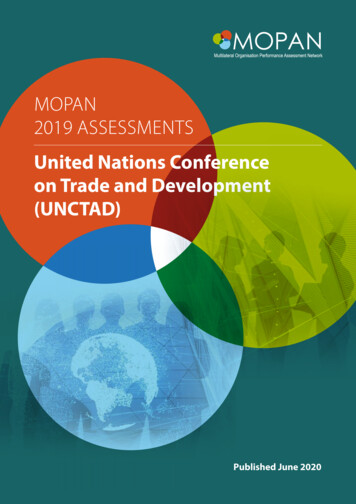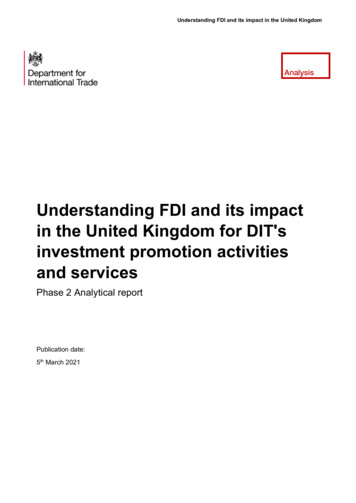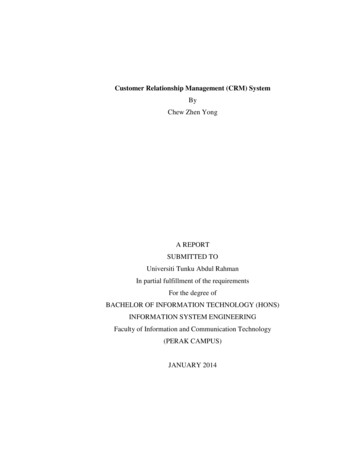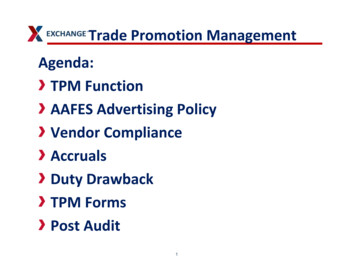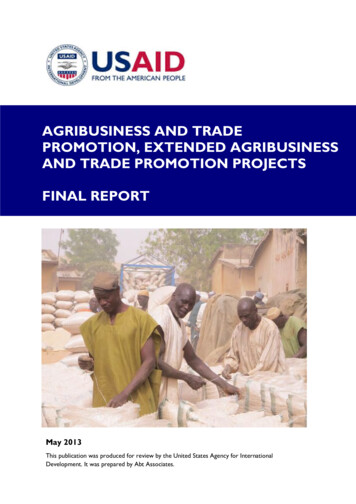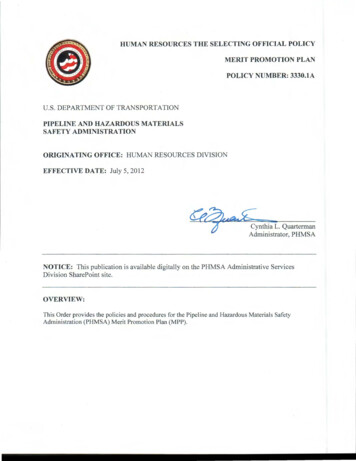
Transcription
Investment Advisory SeriesSeries A, number 3United Nations Conference on Trade and DevelopmentEVALUATING INVESTMENTPROMOTION AGENCIESUnited NationsNew York and Geneva 2008
NoteAs the focal point in the United Nations system forinvestment, and building on 30 years of experience in this area,UNCTAD, through the Division on Investment and Enterprise(DIAE), promotes understanding of key issues, particularly mattersrelated to foreign direct investment (FDI). DIAE also assistsdeveloping countries in attracting and benefiting from FDI and inbuilding their productive capacities and internationalcompetitiveness. The emphasis is on an integrated policy approachto investment and enterprise development.The term “country” as used in this publication also refers,as appropriate, to territories or areas. The designations employedand the presentation of the material do not imply the expression ofany opinion whatsoever on the part of the Secretariat of the UnitedNations concerning the legal status of any country, territory, city orarea, or of its authorities, or concerning the delimitation of itsfrontiers or boundaries. In addition, the designations of countrygroups are intended solely for statistical or analytical convenienceand do not necessarily express a judgement about the stage ofdevelopment reached by a particular country or area in thedevelopment process.The material contained in this publication may be freelyquoted or reprinted with appropriate acknowledgement. A copy ofthe publication containing the quotation or reprint should be sent tothe Chief, Investment Facilitation Section, DIAE, UNCTAD, Palaisdes Nations, Room E-10057, CH-1211 Geneva, Switzerland; byfax: (41 22) 917 01 97; or e-mail: iif@unctad.org. Publications areavailable on the website http://www.unctad.org.UNCTAD/DIAE/PCB/2008/2ISSN 1995-6088United Nations Publicationii
Evaluating Investment Promotion AgenciesPrefaceThe Investment Advisory Series provides practical adviceand case studies of best policy practice for attracting and benefitingfrom foreign direct investment (FDI), in line with nationaldevelopment strategies. The Series draws on the experiences gainedin, and lessons learned through, UNCTAD’s capacity- andinstitution-building work in developing countries and countries witheconomies in transition.Series A deals with issues related to investment promotionand facilitation and to the work of investment promotion agencies(IPAs) and other institutions that promote FDI and provideinformation and services to investors. The publications areintended to be pragmatic, with a how-to focus, and include toolkitsand handbooks. The prime target audience for Series A ispractitioners in the field of investment promotion and facilitation,mainly in IPAs.Series B focuses on case studies of best practices in policyand strategic matters related to FDI and development arising fromexisting and emerging challenges. The primary target audience forSeries B is policymakers in the field of investment. Other targetaudiences include civil society, the private sector and internationalorganizations.The Investment Advisory Series is prepared by a group ofUNCTAD staff and consultants in the Policies and Capacitybuilding Branch, under the guidance of James Zhan.This guide was prepared by Jan Smit (UNCTADconsultant) under the supervision of Paul Wessendorp, Chief of theInvestment Facilitation Section. Inputs and advice were receivedfrom Andreas Wigren and Carlos Griffin. The guide benefited fromcomments made by Rory Allan, Chantal Dupasquier and Nishaiii
Ramesh from UNCTAD. Desktop publishing was done by TeresitaVentura.Preparation of this publication was done in cooperationwith the World Association of Investment Promotion Agencies(WAIPA) and was made possible by generous funding from theSwedish International Development Cooperation Agency (SIDA).iv
Evaluating Investment Promotion AgenciesContentsAbbreviations.viiExecutive summary. ixIntroduction . 11. The rationale for evaluating IPA performance . 71.1 Why evaluate?. 71.2 External and internal drivers for evaluation. 91.3 Challenges to effective evaluation . 141.4 Key requirements for successful evaluation . 162. Information sources and basic tools . 192.1 Information and data required for evaluation . 192.2 Basic evaluation tools . 252.3 Evaluation challenges for low-budget IPAs. 303. Method and approaches. 313.1 Doing the right thing: Evaluating the IPA’s role . 313.2 Doing the thing right: Evaluating main management areas . 423.3 Doing evaluation. 584. Conclusions . 61Annex I. A draft survey questionnaire . 63Annex II. Invest in Sweden Agency questionnaire. 67References . 69Selected UNCTAD publications on TNCs and FDI . 71v
Boxes1. IPA evaluation and Good Governance inInvestment Promotion. 82. Challenges to effective evaluation. 143. Evaluation of an IPA: The London Development Agency. 394. Invest in Sweden Agency’s “follow-up system” . 415. Evaluating proposals to obtain funding at Greater HelsinkiPromotion . 446. SWOT analysis of a hypothetical IPA . 497. Evaluating aftercare at an Eastern European IPA. 518. Evaluation targets for operations at ProsperAr (Argentina) . 569. Performance evaluation at the TanzaniaInvestment Centre. 57Figures1. Intervention logic for an IPA . 34Tables1.2.3.4.5.6.Market failures that can underpin the rationale for an IPA . 11Data and information used for evaluation. 23Basic tools for IPA evaluation . 28The logic chain . 38Indicators for human resources evaluation . 45Example of a balanced scorecard for anIPA project manager . 46vi
Evaluating Investment Promotion AgenciesAbbreviationsCATICRMDIAEDTIFDIGGIPGHPHM LUKTIUNUNCTADUNEGcomputer-assisted telephone interviewingcustomer relationship managementDivision on Investment and EnterpriseDepartment of Trade and Industry (UnitedKingdom)foreign direct investmentGood Governance in Investment PromotionGreater Helsinki PromotionHer Majesty’s Treasury (United Kingdom)human resourcesinformation and communication technologyInvest in Sweden AgencyLondon Development AgencyMultilateral Investment Guarantee AgencyOrganisation for Economic Co-operation andDevelopmentNational Investment Development Agency(Argentina)research and developmentregional headquartersstrengths, weaknesses, opportunities and threatsTanzania Investment CentreThink LondonUK Trade and InvestmentUnited NationsUnited Nations Conference on Trade andDevelopmentUnited Nations Evaluation Groupvii
Executive summaryInvestment promotion agencies (IPAs) are potentially keyinstitutions for delivering increased levels of welfare. There hasbeen a rapid increase in the number of IPAs operating throughoutthe world and a growth in the resources dedicated to investmentpromotion since the 1980s.However, there is evidence to suggest that this growth inthe number of and resources employed by IPAs has not beenmatched by a corresponding emphasis on evaluation ofperformance and development of performance evaluation systems.Yet there exists a set of well-defined methodologies for evaluatingpublic programmes, as well as private sector performanceevaluation tools that are readily applicable to IPAs. This guide setsout what some of those tools are and how they can be used in IPAs.It is also recognized that while there is a need forevaluation, driven both by external stakeholders such as fundingministries or donors, and the internal needs of management, thereare some human and technical barriers that may have to beovercome for effective evaluation to take place.The publication takes two different approaches toevaluation: (a) “doing the right thing” and (b) “doing the thingright”. From the first approach, the IPA is looked at in terms of itsreason for being: why is it in operation? One reason for being maybe to counter specific, identified market failures. Once suchfailures are identified, it can be set out how, in a logical way, theIPA intends to deal with those market failures. When this is clear, itis possible, through the evaluation methodology set out in thisguide, to evaluate whether the IPA is doing the right thing, what itshould be doing more of, less of, or not at all.The second approach to evaluation is that of “doing thething right.” That means, given the rationale for its existence,evaluating if the IPA is carrying out the appropriate activities toimplement its mandate and if this is being done in the best possibleway. This approach to evaluation is considered in terms of core
management areas in the IPA: funding, human resourcesmanagement, strategy, marketing and operations. Several tools arepresented for evaluating whether the IPA is “doing the thing right”.An underlying theme is the relationship between the twoapproaches to evaluation. They continually inform each other, asborne out by the fact that they use the same basic tools, data andinformation sources. The types of tools, data and informationrequired for evaluation are listed, along with their respectiveadvantages and disadvantages. Throughout the text, case studies areprovided for illustration. The annexes provide a draft surveyquestionnaire and an example of an actual survey questionnaireused by an IPA.The overall conclusion of this report is that successfulevaluation will enable the IPA to identify the best use of theresources at its disposal. There is a sound body of evaluationmethodology that can be applied to help IPAs do this.Successful evaluation requires attention to both “hard”factors such as data collection and interviewing and “soft” factorssuch as dealing with people and organizations to obtain theircollaboration by being open, inclusive, unbiased and objective.One key implication of IPA evaluation in terms of themethodology presented in this guide is that good performance doesnot necessarily mean that the best “return on investment” within anIPA is being achieved: “doing the thing right” does not necessarilymean “doing the right thing”.Ultimately, the value of evaluation is measured by thechanges that result from such exercises.x
IntroductionInvestment promotion agencies (IPAs) are potentially keyinstitutions for delivering increased levels of welfare through theattraction of foreign direct investment (FDI). To this end, IPAmanagers and staff exercise great efforts, often with great ingenuityin a highly competitive environment. As far back as 1986,Encarnation and Wells said: “Indeed, competition amonggovernments for foreign investment involves strategies that are ascomplex as those adopted by private firms”.1 Since then,competition has intensified. In the absence of ready indicators suchas profit or return on capital, IPAs are required to develop specificmeasures for performance evaluation.Having said this, the reality is that in 2000 an UNCTADsurvey found that “most IPAs state that they do not have any clearperformance indicators, either qualitative or quantitative, forevaluating their achievements”.2 Rapid growth in the number ofIPAs has fuelled a corresponding expansion of funds andemployment. This, coupled with countries’ and regions’ need foreffective marketing strategies to target investors, makes itimperative that funding organizations obtain better insight into whatthe outcomes of their funding activities are. It is also necessary forthe executives and managers of IPAs to determine how they aremost useful and allocate their resources accordingly.There are well-developed procedures for the evaluation ofpublic sector programmes, with established methodologies thathave been developed over time by governments and donororganizations. Guidelines have been published and are readilyavailable from national governments and organizations, such as the12Encarnation D J and Wells L T Jr (1986). “Competitive Strategies inGlobal Industries: A View From Host Governments”, in Porter M E(ed): Competition in Global Industries. Boston: HBS.UNCTAD (2002). The World of Investment Promotion at a Glance:32.
IntroductionOrganisation for Economic Co-operation and Development(OECD), the United Nations (UN) and the World Bank.3This guide presents a generic methodology for evaluationof IPAs, based on a body of accepted research, which can beadjusted to fit the specific circumstances of IPAs worldwide. Theprimary objective of evaluation is to learn from experience, leadingultimately to improved performance and returns on public andprivate funds invested. Evaluation achieves this through two basicmechanisms:(a) Accountability – looking backward, evaluation helps to explainto stakeholders what has been achieved by a programme andthe use made of public funds;(b) Improving future programmes – looking forward, evaluationhelps ensure that lessons from the past are learnt and used toimprove existing and future programmes.Defining “evaluation”Evaluation involves determining as systematically andobjectively as possible the relevance, efficiency, effectiveness,sustainability and impact of activities in light of their objectives.Evaluations can assess both processes (for example setting up,managing and implementing a programme to deliver an outcome)and outcomes themselves (the ultimate objectives that a programmeis seeking to achieve). A variety of things can potentially be subjectto evaluation: a project (e.g. a specific inward investment), aprogramme (e.g. a new marketing initiative for a specific sector), anorganizational function in the IPA (e.g. aftercare), a process in theIPA (e.g. enquiry handling), the whole IPA organization, or theeconomic impact of the IPA. However, evaluation does not stopthere. It also asks, “Are there better ways of doing it?” and makes a3See the references for this guide.2
Evaluating Investment Promotion Agenciescritical contribution to organizational learning and institutionalperformance.4The definition of “evaluation” used in the UN system is:“ an assessment, as systematic and impartial as possible, of anactivity, project, programme, strategy, policy, topic, theme, sector,operational area, institutional performance, etc. It focuses onexpected and achieved accomplishments, examining the resultschain, processes, contextual factors and causality, in order tounderstand achievements or the lack thereof. It aims at determiningthe relevance, impact, effectiveness, efficiency and sustainability of interventions and contributions. An evaluation should provideevidence-based information that is credible, reliable and useful,enabling the timely incorporation of findings, recommendations andlessons.”.5In this guide, the term “evaluation” is used in two differentsenses: to assess (a) if the IPA is “doing the right thing” and (b) if itis “doing the thing right”. In the first sense of the word (sometimescalled “existential” evaluation), evaluations can be carried outbefore launching a programme (ex ante), in the course of aprogramme (mid-term), or once it is concluded (ex post). The focusof this guide is on mid-term and ex post evaluation, “retrospectiveanalysis of a project, programme or policy to assess how successfulor otherwise it has been, and what lessons can be learnt for thefuture”,6 but the same method could be used for ex ante evaluationas well.The second sense in which the term is used, “doing thething right”, assesses the effectiveness of achieving those goalsidentified as the “right” things. Evaluation in this sense aims to456UNEG (2005). Norms for Evaluation in the UN System: 4.Ibid.HM Treasury. The Green Book. Appraisal and Evaluation in CentralGovernment. The Stationery Office: 102.3
Introductionanswer questions such as: How many resources are being used towin specific investment projects or access a particular targetmarket? How does that compare with other target markets? Howproductive is our team? How useful is our website? What are thebarriers to our organization’s improved performance? This kind ofevaluation is closely linked to performance measurement7 and iscarried out continuously, rather than at periodic intervals of a fewyears, as in the first case.Answers to the question “Are there better ways of doing it?”are mainly obtained from examining the organization internally butoften also from looking at what others are doing and comparing theIPA with them through benchmarking exercises. The elements are,however, interdependent: good goal-setting and activity definitionmake it easier to track performance, which then makes it easier tocompare goals and activities with other IPAs.Furthermore, evaluation should be seen as part of anongoing organizational learning process, not a one-off exercise, andorganizations should develop a culture of evaluation.Aims of the guideThe aims of this guide are to:(a) Make clear why it is important to evaluate the IPA, and identifysome challenges to evaluation;(b) Consider the advantages and disadvantages of differentinformation sources and tools;(c) Set out a sound methodology to evaluate IPA performance,including both quantitative and qualitative measures, and takinginto account differences among IPAs.7Useful guidance on monitoring in an IPA is provided in MIGA(2000). Investment Promotion Toolkit 8. Monitoring and EvaluationActivities in Investment Promotion Agencies.4
Evaluating Investment Promotion AgenciesThe challenge of IPA evaluationA foreign investment decision made by a firm is the resultof a wide range of factors, both internal and external to theorganization. In such a context, evaluating the IPA’s contributionto inward investment can be quite complex. The central question isone of attribution – what has been the role of the IPA?Once this question has been answered, the IPA shouldknow:(a) What it should be doing but is not;(b) What it should be doing and is, but should do more or less of,or better;(c) What it should not be doing at all.Only when this is clear can the IPA develop effectiveoptions and select optimal strategies for the future.The structure of the guideChapter 1 of this guide looks at the rationale for IPAevaluation and some challenges to such evaluation; chapter 2 dealswith various information sources and evaluation tools; chapter 3sets out an evaluation methodology; and chapter 4 concludes theguide.5
1. The rationale for evaluating IPA performanceThe aim of this chapter is to make clear the importance ofcarrying out evaluation exercises. We ask why there is a need forevaluation and consider who has an interest in evaluation of theIPA, both internally and externally. We then address someevaluation challenges and discuss key requirements for successfulevaluation.1.1Why evaluate?IPA managers are continually faced with making decisionssuch as:(a) Should we carry out general awareness programmes or focus ontargeted investment generation?(b) How do we ensure that we have the appropriate mix of staff,and how do we motivate them?(c) Do we establish or close down foreign offices?(d) What do our clients value most?(e) What do we think is the most valuable role we can play?(f) What should we be doing better? How can we do it better?(g) What should we do to ensure that the benefits of ourintervention are maximized in terms of, for example, jobcreation or technology transfer?(h) How is our region doing compared to others?(i) Do we invest more in attracting new firms to our region or inworking with those already established here?These are just some questions that, to be answered, requiresome type of evaluation. The common themes underlying thesequestions are those of increased effectiveness, improvedperformance, and better value for money. These will ultimatelycontribute to justifying the existence of the IPA and help itsmanagement decide what services it should offer and how it shoulddeliver them. However, it is not just IPA managers who have aninterest in securing best returns on the investment in the IPA:external organizations with a stake in the IPA have a similar
Chapter 1. The rationale for evaluating IPA performanceinterest. In addition, evaluation contributes to good governance,which is a high priority for many governments (see box 1).Box 1. IPA evaluation and Good Governance in InvestmentPromotionIn addition to providing direction for the improvement of anIPA’s efficiency and impact, evaluation adds to the quality of a country’sinvestment climate by promoting Good Governance in InvestmentPromotion (GGIP).Revisiting IPA goals, processes and performance throughevaluation provides a basis for holding its managers and governmentaccountable when they do not adequately meet their mission. Tomaximize accountability, negative evaluation results should be followedby remedial action whenever possible, and by adequate explanationswhenever not.Making evaluation results public is a big step towardstransparency. Publicity keeps pressure on the IPA to meet its mission inrelation to investors and the country. It acts as its own penalty and reward,embarrassing poor performers into doing better and giving goodperformers the encouragement and political recognition to continue. Here,transparency refers to the process of evaluation as well. If the integrity ofan evaluation is suspect, its results may not be trusted and its benefits maybe lost – for IPA performance and GGIP.Source: UNCTAD.Evaluation activities stem from the desire to understand andameliorate shortcoming and build on strengths, enablingimprovements to be brought about by learning and applying lessonsfrom experience. The reasons for evaluation can be external andinternal. These two drivers for evaluation will now be discussed inturn.8
Evaluating Investment Promotion Agencies1.2External and internal drivers for evaluationExternal organizationsIt is possible to distinguish four groups of externalorganizations that have an interest in IPA evaluation. These are:(a) Government departments that provide funding for IPAs;(b) Other external organizations or stakeholders that providefunding or other forms of support for IPAs;(c) Donor organizations;(d) Other affected organizations.The nature of these groups’ interests will be discussedbelow.Government finance departmentsHaving an IPA is not just a matter of national or subnational prestige – it needs to be useful, and to be able to prove thatit is useful. Thus for example, a World Bank paper asks: “Does aCountry Need a Promotion Agency to Attract Foreign DirectInvestment?”8 The author suggests, based on a survey of 58countries, that greater investment promotion is associated withgreater FDI flows. Findings also suggest that IPA effectiveness isrelated to investment climate; the scope of activities the IPAundertakes (in particular the role of policy advocacy increaseseffectiveness, when compared with investment generation andtargeting strategies that can be risky and expensive); and, that thecloser the reporting is to the highest policymakers or the privatesector, the more effective is the IPA. The point is that having aspecial agency for the marketing of a location and generation of8Morisset J (2003). “Does a Country Need a Promotion Agency toAttract Foreign Direct Investment? A Small Analytical ModelApplied to 58 Countries”, Policy Research Working Paper 3028.FIAS, World Bank. Washington, DC.9
Chapter 1. The rationale for evaluating IPA performanceinward investment is under scrutiny and being questioned bypolicymakers.In most market-oriented economies, finance departments ortreasuries need a strong economic rationale before they areprepared to intervene in the economy. In such economies, therationale for intervening is built on identification of a failure in themarket to produce what are considered optimal outcomes in termsof resource allocation, production and distribution. Typical marketfailures in an inward investment context, and how they canunderpin the rationale for an IPA, are presented in table 1.For example, the creation of the Invest in Britain Bureau(now UK Trade and Investment, UKTI) was based on a rationale ofinformation problems. Research at the time (late 1970s) found USinvestment that would traditionally have gone to the UnitedKingdom (UK) was going to Germany instead. The Britishauthorities took the view that this was due to incorrect perceptionsof what was happening in the UK (based on TV, press and othermedia reports). An institution that would provide an “accurate”portrayal of developments in the UK to foreign investors wouldcounter such misperceptions and ensure a continued flow of USinvestment to the UK. In addition to providing information toforeign investors, the IPA would coordinate the activities of subnational IPAs in the UK to produce better results for the country asa whole.Different countries are faced with different circumstancesthat would justify intervention. For example, if there is only onemonopoly supplier present, the IPA may assist a foreign companyto enter the host market to change the competitive situation. Or itcould be the case that a whole economy is transforming from aplanned to a market economy, and this requires not only10
Evaluating Investment Promotion AgenciesTable 1. Market failures that can underpin the rationale for an IPAMarket failurePublic goodsand onproblemsDescriptionIt may be impossible to exclude non-clients fromconsuming IPA services. If, for example, an IPA carriesout an advertising campaign that improves the country'simage abroad, all inhabitants may benefit as a result. Butif it were left up to the clients to pay for the services, thefunding would only reflect their benefit from the IPA. Thebenefit of its services to others would not be taken intoaccount. In such a case, the IPA may become underfunded. If, on the other hand, the IPA is publicly funded,non-clients benefiting from the IPA's work would also bepaying for the services (through taxes). In theory at least,the greater supply of IPA services would then betterreflect the total benefit to society.Positive externalities occur when benefits accrue to thosenot involved in a transaction. In the case of inward FDI, aforeign company may bring e.g. new technologies ormanagement techniques to the host country. Theestablishment of a foreign firm can also contribute to thedevelopment of suppliers, better training, and transfer ofskills. In some cases, other companies and individuals inthe host country can also benefit from these.Insufficient (or incorrect) information can lead toinefficient markets. This means that people may be betteroff if these information gaps can be filled. An IPA can actas an information provider to foreign investors. There areseveral situations in which the IPA can fulfil this role,including: Smaller firms or individuals rarely have resources toacquire knowledge about location decisions; Larger firms do not always have access to knowledgeor know where to find it, even if they have resources; International perceptions of a region may not reflectbusiness realities; The business sector rarely has sufficient knowledge ofthe public sector to find its way around. Especially forforeigners, an IPA providing a “road map” may be veryuseful; There is a role for a “trusted intermediary” to introducethe foreigner to the domestic business and privatesector networks.Coordination problems may prevent market participantsfrom overcoming the above-mentioned problems or theirconsequences. Market-driven initiatives to solve thesemay not be forthcoming (e.g. to reduce or coordinate subregional competition for FDI). The IPA can act as a centrefor dealing with coordination between economic agents.11
Chapter 1. The rationale for evaluating IPA performancecompetition-related interventions by the IPA but also interventionspertaining to information and coordination problems. IPAs couldincorporate the rationale in their mandate or founding charter,which would then become the yardstick against which they areevaluated.As IPAs evolve and their budgets grow, pressure willincrease on them to justify their continued public support. This isquite reasonable, as governments have to be sure that public fundsare being spent in the best way. It would be wise of IPAs to preempt government questions about continued funding, and anyjustification should be based on a sound economic rationale.Other external organizations or stakeholders that provide resourcesOther external organizations that provide funding or otherforms of
management, strategy, marketing and operations. Several tools are presented for evaluating whether the IPA is "doing the thing right". An underlying theme is the relationship between the two approaches to evaluation. They continually inform each other, as borne out by the fact that they use the same basic tools, data and information sources.
